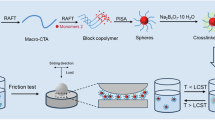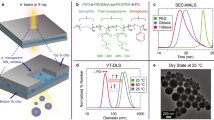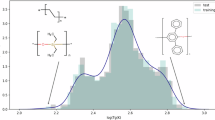Abstract
A short-range-ordered, soft glassy colloidal array (SGCA) exhibits angle-independent and non-iridescent structural color. To control the angle-independent structural color using external stimuli, a thermosensitive SGCA composed of block copolymer, poly(benzyl methacrylate)-block-poly(methyl methacrylate) (PBnMA-b-PMMA), grafted silica nanoparticles was prepared in an ionic liquid. The thermosensitive properties were studied over a wide range of particle concentrations and temperatures. In the dilute suspension, the outer PBnMA blocks shrunk at high temperatures because of their lower critical solution temperature behavior, whereas the inner PMMA blocks gave rise to steric repulsion, stabilizing the particles against aggregation even at the high temperatures. A blue shift of the reflection peak with increasing temperature was observed for the glassy arrays at semidilute particle concentrations; however, an opposite red shift was observed at high particle concentrations. This unexpected red shift in the highly concentrated suspension was interpreted as swelling of the inner PMMA blocks associated with the desolvation and segregation of thermosensitive PBnMA blocks in the outermost region of the particles. This temperature-sensitive continuous shift of the reflection peak demonstrates the potential application of thermosensitive SGCAs as structural colored materials.
Similar content being viewed by others
Log in or create a free account to read this content
Gain free access to this article, as well as selected content from this journal and more on nature.com
or
References
Pusey, P. N. & van Megen, W. Phase behavior of concentrated suspensions of nearly hard colloidal spheres. Nature 320, 340–342 (1986).
Weeks, E. R., Crocker, J. C., Levitt, A. C., Schofield, A. & Weitz, D. A. Three-dimensional direct imaging of structural relaxation near the colloidal glass transition. Science 287, 627–631 (2000).
Prum, R. O., Cole, J. A. & Torres, R. H. Blue integumentary structural colours in dragonflies (Odonata) are not produced by incoherent Tyndall scattering. J. Exp. Biol. 207, 3999–4009 (2004).
Prum, R. O. & Torres, R. H. Structural colouration of mammalian skin: convergent evolution of coherently scattering dermal collagen arrays. J. Exp. Biol. 207, 2157–2172 (2004).
Prum, R. O., Torres, R. H., Williamson, S. & Dyck, J. Coherent light scattering by blue feather barbs. Nature 396, 28–29 (1998).
Harun-Ur-Rashid, M., Imran, A. B., Seki, T., Ishii, M., Nakamura, H. & Takeoka, Y. Angle-independent structural color in colloidal amorphous arrays. ChemPhysChem 11, 579–583 (2010).
Ge, D., Yang, L., Wu, G. & Yang, S. Spray coating of superhydrophobic and angle-independent colored films. Chem. Commun. 50, 2469–2472 (2014).
Kohri, M., Nannichi, Y., Taniguchi, T. & Kishikawa, K. Biomimetic non-iridescent structural color materials from polydopamine black particles that mimic melanin granules. J. Mater. Chem. C 3, 720–724 (2015).
Shi, L., Zhang, Y., Dong, B., Zhan, T., Liu, X. & Zi, J. Amorphous photonic crystals with only short-range order. Adv. Mater. 25, 5314–5320 (2013).
Takeoka, Y. Stimuli-responsive opals: colloidal crystals and colloidal amorphous arrays for use in functional structurally colored materials. J. Mater. Chem. 1, 6059–6074 (2013).
Lee, I., Kim, D., Kal, J., Baek, H., Kwak, D., Go, D., Kim, E., Kang, C., Chung, J., Jang, Y., Ji, S., Joo, J. & Kang, Y. Quasi-amorphous colloidal structures for electrically tunable full-color photonic pixels with angle-independency. Adv. Mater. 22, 4973–4977 (2010).
Gotoh, Y., Suzuki, H., Kumano, N., Seki, T., Katagiri, K. & Takeoka, Y. An amorphous array of poly(N-isopropylacrylamide) brush-coated silica particles for thermally tunable angle-independent photonic band gap materials. N. J. Chem. 36, 2171–2175 (2012).
Ueno, K., Inaba, A., Sano, Y., Kondoh, M. & Watanabe, M. A soft glassy colloidal array in ionic liquid, which exhibits homogeneous, non-brilliant and angle-independent structural colours. Chem. Commun. 24, 3603–3605 (2009).
Ueno, K., Sano, Y., Inaba, A., Kondoh, M. & Watanabe, M. Soft glassy colloidal arrays in an ionic liquid: colloidal glass transition, ionic transport, and structural color in relation to microstructure. J. Phys. Chem. B 114, 13095–13103 (2010).
Yoshinaga, K., Fujiwara, K., Mouri, E., Ishii, M. & Nakamura, H. Stepwise controlled immobilization of colloidal crystals formed by polymer-grafted silica particles. Langmuir 21, 4471–4477 (2005).
Ohno, K., Morinaga, T., Takeno, S., Tsujii, Y. & Fukuda, T. Suspensions of silica particles grafted with concentrated polymer brush: a new family of colloidal crystals. Macromolecules 39, 1245–1249 (2006).
Yoshinaga, K., Chiyoda, M., Ishiki, H. & Okubo, T. Colloidal crystallization of monodisperse and polymer-modified colloidal silica in organic solvents. Colloids Surf A 204, 285–293 (2002).
Ueno, K., Inaba, A., Kondoh, M. & Watanabe, M. Colloidal stability of bare and polymer-grafted silica nanoparticles in ionic liquids. Langmuir 24, 5253–5259 (2008).
Ueno, K., Inaba, A., Ueki, T., Kondoh, M. & Watanabe, M. Thermosensitive, soft glassy and structural colored colloidal array in ionic liquid: colloidal glass to gel transition. Langmuir 26, 18031–18038 (2010).
Ueki, T. & Watanabe, M. Lower critical solution temperature behavior of linear polymers in ionic liquids and the corresponding volume phase transition of polymer gels. Langmuir 23, 988–990 (2007).
Ueki, T. Stimuli-responsive polymers in ionic liquids. Polym J. 46, 646–655 (2014).
Li, D., Jones, G. L., Dunlap, J. R., Hua, F. & Zhao, B. Thermosensitive hairy hybrid nanoparticles synthesized by surface-initiated atom transfer radical polymerization. Langmuir 22, 3344–3351 (2006).
von Werne, T. & Patten, T. E. Atom transfer radical polymerization from nanoparticles: a tool for the preparation of well-defined hybrid nanostructures and for understanding the chemistry of controlled/’living’ radical polymerizations from surfaces. J. Am. Chem. Soc. 123, 7497–7505 (2001).
Ueki, T., Karino, T., Kobayashi, Y., Shibayama, M. & Watanabe, M. Difference in lower critical solution temperature behavior between random copolymers and a homopolymer having solvatophilic and solvatophobic structures in an ionic liquid. J. Phys. Chem. B 111, 4750–4754 (2007).
Wu, T., Efimenko, K. & Genzer, J. Combinatorial study of the mushroom-to-brush crossover in surface anchored polyacrylamide. J. Am. Chem. Soc. 124, 9394–9395 (2002).
Brittain, W. J. & Minko, S. A structural definition of polymer brushes. J. Polym. Sci. Pol. Chem. 45, 3505–3512 (2007).
Takeoka, Y. Angle-independent structural colored amorphous arrays. J. Mater. Chem. 22, 23299–23309 (2012).
Rundquist, P. A., Kesavamoorthy, R., Jagannathan, S. & Asher, S. A. Thermal diffuse scattering from colloidal crystals. J. Chem. Phys. 95, 1249–1257 (1991).
Acknowledgements
This work was supported by a Grant-in-Aid for Scientific Research from the Ministry of Education, Culture, Sports, Science and Technology (MEXT) of Japan (A/23245046 and S/15H05758).
Author information
Authors and Affiliations
Corresponding author
Ethics declarations
Competing interests
The authors declare no conflict of interest.
Additional information
Supplementary Information accompanies the paper on Polymer Journal website
Supplementary information
Rights and permissions
About this article
Cite this article
Ueno, K., Fukai, T. & Watanabe, M. Thermosensitive soft glassy colloidal arrays of block-copolymer-grafted silica nanoparticles in an ionic liquid. Polym J 48, 289–294 (2016). https://doi.org/10.1038/pj.2015.105
Received:
Revised:
Accepted:
Published:
Issue date:
DOI: https://doi.org/10.1038/pj.2015.105
This article is cited by
-
Soft materials based on colloidal self-assembly in ionic liquids
Polymer Journal (2018)
-
Interface manipulated two-phase nanostructure in a triblock terpolymer with a short middle segment
Polymer Journal (2016)



